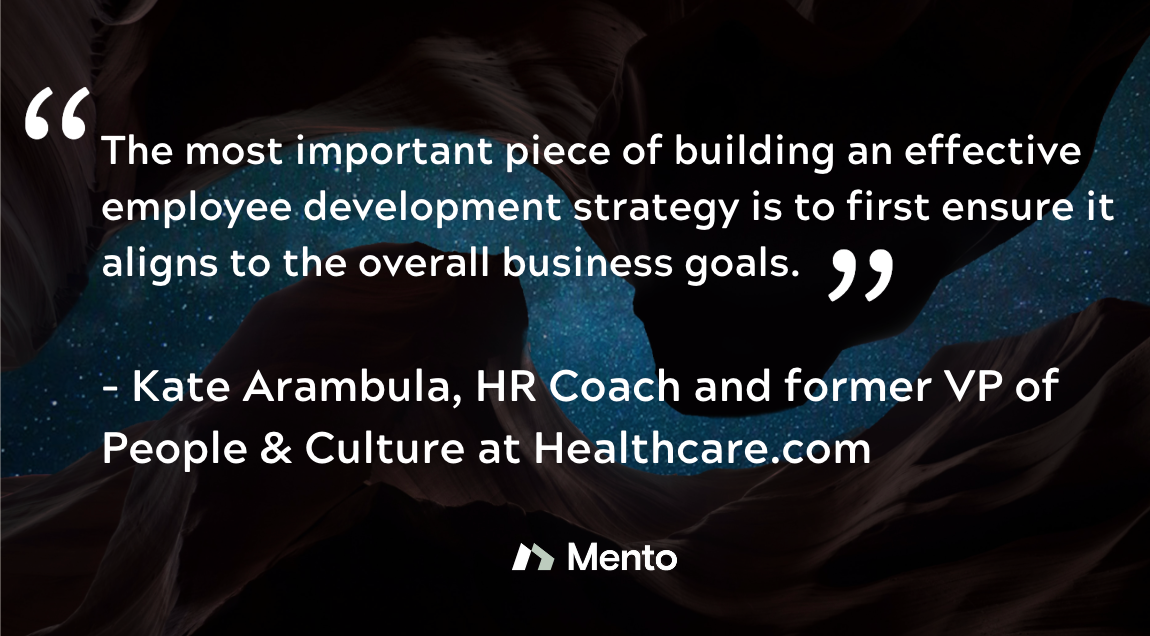Leadership
People Ops
Empowering Human Resource Leaders to support employee development

In today's rapidly evolving workplace, employee development has become table stakes for organizations and their employees.
In LinkedIn’s 2022 Global Talent Trends report, 59% of employees listed professional development as the top area their business should invest in to improve company culture.
In this blog post, we'll explore the ways that human resource leaders can support employee development today, the pros and cons of each method and take a brief look into the future of the space.
The golden rule of employee development
In discussing employee development best practices with HR leaders, the same important “rule” kept coming up in our conversations.
“The most important piece of building an effective employee development strategy is to first ensure it aligns with the overall business goals” said Kate Arambula, Human Resources Coach and former VP of People & Culture at HealthCare.com.
Following this rule holds us accountable to making decisions that will impact our most important goals and provides us with a feedback mechanism for when they aren’t. This rule ultimately ensures that you are investing in the right people, on the right teams, at the right time with methods that work.
Make sure to keep this “rule” in mind as you consider the following employee development methods stated in this article.

The current landscape of employee development
There are several methods human resource leaders can use to support employee development, and each comes with benefits and potential drawbacks. Here, we’ll outline each method.
Training and workshops
Training and workshops provide employees with the opportunity to acquire new skills and knowledge, which can improve their job performance and effectiveness. Training can even help employees stay up-to-date with industry trends and tech changes. We find this is particularly useful for engineers and others working at the intersection of rapidly changing technology and the application.
However, training and workshops can have their downsides. Developing and delivering training programs can be expensive, especially if they involve external trainers or require employees to travel. But most of all, it’s the short-term nature of training and workshops that are the most limiting. It’s not as easy to take what you’ve learned and automagically apply it to your work. For example, a workshop on team communication is valuable in setting a baseline foundation, aligning on what “good” looks like and providing tactical tips to implement learnings. What's really meaningful here is how you take what you’ve learned and integrate it into the day-to-day of your work. Having support systems and follow ups to help bridge this gap between learning and implementation is key.
Coaching and mentorship
Coaching and mentoring are commonly used by businesses to improve employee performance, maximize potential, improve wellbeing, develop new skills, support leaders and much more. According to CNBC, almost 50% of workers who don’t have a mentor say they’ve considered quitting their job in the past three months, compared with just 25% of those who do have a mentor. Other research found that 70% of people who receive coaching report improved performance at work.
Coaching is often provided on a one-on-one basis by a qualified coach. A knowledgeable coach can provide tools, training, advice and feedback, generally through a structured program. Meanwhile, mentoring involves a nurturing relationship where a more experienced individual directly shares their knowledge to a less experienced individual.
At Mento we provide an 80/20 blend of coaching and mentorship that takes the best parts of both career coaching and mentorship for a different approach to help people develop and grow.
Personalized guidance from a mentor or coach can be highly effective in addressing individual development needs, and is inherently personalized. However, coaching and mentorship can be resource-intensive — and may not always be easily scalable across your organization. What we find is that most of our partners target an initial cohort where coaching will have the biggest impact across their organization to start and prove out the value. Managers can also tap into their own team budgets or team L&D stipends to make coaching available to their team.
Feedback and performance reviews
Managers can use feedback to motivate, support, correct and regulate work efforts across their team members. Empowering managers to deliver regular feedback and have performance reviews also ensures that your managers and employees are aligned on standards and expectations.
Employees who say their managers gave them “meaningful” feedback in the past week were four times more likely to be engaged at work. Frequent, constructive feedback allows managers to act as coaches who recognize and nurture employees’ strengths, rather than bosses, who delegate tasks and micromanage. This empowering relationship where managers give advice, offer assistance, and advocate for their employees helps develop trust, a key factor in engaging employees.
Regular feedback sessions are critical — they help employees understand their strengths and areas for improvement. However, how feedback is delivered can make or break how it’s received. Ensuring that managers and the entire company is equipped to have meaningful and productive feedback conversations is crucial to their success and a tool for developing trust and high performance organizations. This Harvard Business School article offers a solid framework that can be used to empower your managers to give effective feedback.
Learning and development platforms
In our digital age, you may consider turning to online learning and development platforms to facilitate employee growth.
Using online learning and development platforms within an organization has come to be an effective way to improve performance and innovation. IBM conducted a study that found that for every dollar spent on employee e-learning and training, there is a $30 increase in overall employee productivity.
Online platforms offer a wide range of resources that employees can easily access. However, the lack of personalization may make it challenging for employees to find content that truly addresses their needs and is easy to understand and implement. We often find that over time people stop using and engaging with these tools, so we recommend not over investing in expensive annual licenses until you find the content and platform that works for your business and employees.
Stretch projects
As the name implies, stretch projects “stretch” or challenge an employee to think and act outside their comfort zone or day-to-day job.
In one study conducted by the Harvard Business Review of 823 executives, 71% of respondents said stretch assignments had the biggest impact on unleashing their potential. In another, conducted by Korn Ferry, stretch assignments were named the most valuable developmental experience, ahead of things like training, 360-degree assessments, and even exposure to senior leaders.
These opportunities allow employees to gain new skills and experiences within an organization — all without leaving their role. However, due to their nature, stretch assignments can be disruptive or require additional support from their manager or other team members. Make sure to give yourself managers time and space to co-create the project with an employee -- and build in the systems, support, and clarity to set them up for success.
The future of employee development
As we look to the future, employee development is poised to become even more dynamic and employee-centric.
To remain a competitive employer, it’s important to keep up with these changes and recognize that it takes more than ever to keep employees engaged, productive, and happy at work and in their roles. Organizations should embrace technological and workplace trend shifts to stay ahead of the curve. Artificial intelligence (AI) and data analytics will enable personalized learning journeys tailored to individual needs and preferences. Additionally, the rise of remote work will reshape the way development programs are delivered, making them more accessible to geographically dispersed teams.
Thought leader Josh Bersin highlights this shift, stating: "The future of employee development is all about personalization and continuous learning. Organizations that invest in technologies that support these trends will be at a significant advantage."
Additional support for employee development
Want extra support to move faster? Mento’s 80/20 blend of coaching and mentorship helps your people excel at work. Give your teams the support they need to grow, develop and thrive: Schedule a Mento demo today.
Recent articles
Leadership Development
Guide
Guide: Developing Resilient Leaders in 2025
Leadership Development
On-demand Webinar
Building Resilient Leaders in 2025 On-Demand Webinar
Leadership Development
On-demand Webinar
Measuring L&D Outcomes in 2025 On-Demand Webinar
Leadership Development
On-demand Webinar
Rethinking How We Support Managers On-Demand Webinar
Your coach is your...
